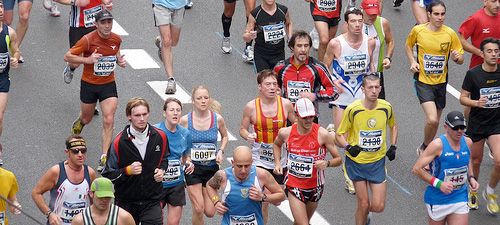
The first installment in this series covered some basic running tips that helped me get started. Now it’s time to Get Serious. Here are the tips that have helped me get to my next running level.
Set realistic goals.
Once I got my time down to 12-minute miles, I set a goal to get down to 11-minute miles. Once I hit 11, I revised my goal down to 10. If I had tried to go all the way from 12 to 10 I may have given up because it’s too big of a chunk to shave off.
Find a buddy.
It’s harder to blow off a day of running when your crew are all planning on going. It also helps to run with a few people who are faster than you. It forces you to try to keep up.
Use technology.
I love my Garmin Forerunner GPS. I like being able to look at my lap pace while i run and making adjustments on the fly. (I don’t use the heart rate monitor, though.) I also like running with compression sleeves
. It may all be in my head, but I feel less cramping and calf fatigue, particularly during longer runs.
Up your mileage.
I noticed a bigger difference in my 5k time when I started running 4 miles 3x a week instead of trying to run 5k 3x a week super fast.
Don’t be afraid to try a run/walk combo for your first half or full marathon.
I recommend this book by Jeff Galloway and his method. It can be easy to get discouraged when you start getting into 7+ mile runs in your training, and a 3/1 run/walk ratio helped make the longer runs bearable.
It’s a race!
There is no day quite like race day. There’s excitement in the air, a feeling of camaraderie with thousands of people, and long lines at the port-a-potty before start time. It’s hard to pace yourself during that first mile, but if you do, it feels amazing to pass a whole bunch of people in the last 1/10 of a mile.
Listen to your body.
After a few injuries, I’ve learned that pain is my body’s way of letting me know something’s not right. There are different types of pain, and sometimes it’s just soreness or tired muscles, but there’s not shame in stopping and walking for a minute, five minutes, or the rest of the way. Also, if you switch shoes and you notice pain in a new spot, STOP. My worst injury was caused by switching running shoes (while I was still heel-striking) and running through knee pain. If you do decide to make the switch to mid/forefoot running, your calves will be incredibly sore the day after that first run, so make sure you ice them down and take it easy with your mileage.
Mind the variables.
Some days I feel like I am running effortlessly, and other days feel like a slog. For me, the optimal running conditions are about 65 degrees and 50% humidity. In the Florida summers, I get to run in about 78 degree heat and 80% humidity, which adds about a minute to my per-mile pace. Also, being hydrated before my runs is very important. TMI alert: I check that my pee is almost clear before I go for a run. Also, I could write a few hundred words on what to eat before runs, but if I am going out for a 5k or 4 miles, I usually have half a banana or a slice of toast with peanut butter. Not getting enough sleep the night before will also affect how my run feels, so I try not to beat myself up if I have days where I am just slow.
My goals for the fall are to run a half-marathon with no walks (except walking through the water stations) and breaking 29 minutes in a timed 5k race. Do you have any tips or goals that have helped you become a better runner?